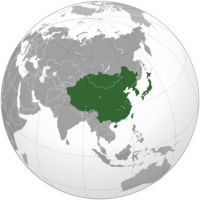East Asia
East Asia is the eastern region of Asia, which is defined in both geographical and ethno-cultural terms. The modern states of East Asia include China (People's Republic of China), Hong Kong (SAR of PRC), Japan, Macau (SAR of PRC), Mongolia, North Korea (Democratic People's Republic of Korea), South Korea (Republic of Korea) and Taiwan (Republic of China). The East Asian states of China, North Korea, South Korea and Taiwan are all unrecognized by at least one other East Asian state due to severe ongoing political tensions in the region, specifically the division of Korea and the political status of Taiwan. Hong Kong and Macau, two small coastal quasi-dependent territories located in the south of China, are officially highly autonomous but are under de jure Chinese sovereignty. North Asia borders East Asia's north, Southeast Asia the south, South Asia the southwest and Central Asia the west. To the east is the Pacific Ocean and to the southeast is Micronesia (a Pacific Ocean island group, classified as part of Oceania).
East Asia, especially Chinese civilization, is regarded as one of the earliest cradles of civilization. Other ancient civilizations in East Asia that still exist as independent countries in the present day include the Japanese, Korean and Mongolian civilizations. Various other civilizations have existed in East Asia during ancient times but have since been absorbed into neighboring civilizations in the present day, such as Tibet, Baiyue, Manchuria and Ryukyu, among many others. Taiwan has a relatively young history in the region after the prehistoric era; originally, it was a major site of Austronesian civilization prior to colonization by European colonial powers and China from the 17th century onward. For thousands of years, China largely influenced East Asia as it was principally the leading civilization in the region exerting its prestige and influence onto its neighbors. Historically, societies in East Asia have fallen within the Chinese sphere of influence, and East Asian vocabulary and scripts are often derived from Classical Chinese and Chinese script. The Chinese calendar preserves traditional East Asian culture and serves as the root to which many other East Asian calendars are derived from. Major religions in East Asia include Buddhism (mostly Mahayana), Confucianism and Neo-Confucianism, Taoism, Ancestral worship, and Chinese folk religion in Mainland China, Hong Kong, Macau and Taiwan, Shintoism in Japan, and Christianity, and Sindoism in Korea. Tengerism and Tibetan Buddhism is prevalent among Mongols and Tibetans while other religions such as Shamanism are widespread among the indigenous populations of northeastern China such as the Manchus. Major languages in East Asia include Mandarin Chinese, Japanese, and Korean. Major ethnic groups of East Asia include the Han (mainland China, Hong Kong, Macau, Taiwan), Yamato (Japan) and Koreans (North Korea, South Korea). Mongols, although not as populous as the previous three ethnic groups, constitute the majority of Mongolia's population. There are 76 officially-recognized minority or indigenous ethnic groups in East Asia; 55 native to mainland China (including Hui, Manchus, Chinese Mongols, Tibetans, Uyghurs and Zhuang in the frontier regions), 16 native to the island of Taiwan (collectively known as Taiwanese indigenous peoples), one native to the major Japanese island of Hokkaido (the Ainu) and four native to Mongolia (Turkic peoples). Ryukyuan people are an unrecognized ethnic group indigenous to the Ryukyu Islands in southern Japan, which stretch from Kyushu Island (Japan) to Taiwan. There are also several unrecognized indigenous ethnic groups in mainland China and Taiwan.
East Asians comprise around 1.7 billion people, making up about 38% of the population in Continental Asia and 22% of the global population. The region is home to major world metropolises such as Beijing, Hong Kong, Seoul, Shanghai, Taipei, and Tokyo. Although the coastal and riparian areas of the region form one of the world's most populated places, the population in Mongolia and Western China, both landlocked areas, is very sparsely distributed, with Mongolia having the lowest population density of a sovereign state. The overall population density of the region is 133 inhabitants per square kilometer (340/sq mi), about three times the world average of 45/km2 (120/sq mi).
East Asia has some of the world's largest and most prosperous economies: Mainland China, Japan, South Korea, Taiwan, Hong Kong, and Macau.
Chat rooms • What links here • Copyright info • Contact information • Category:Root
